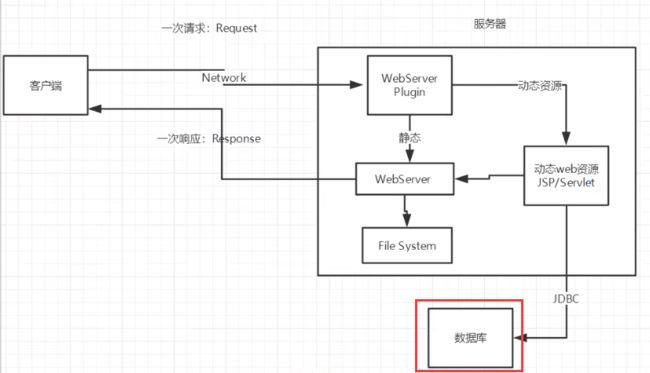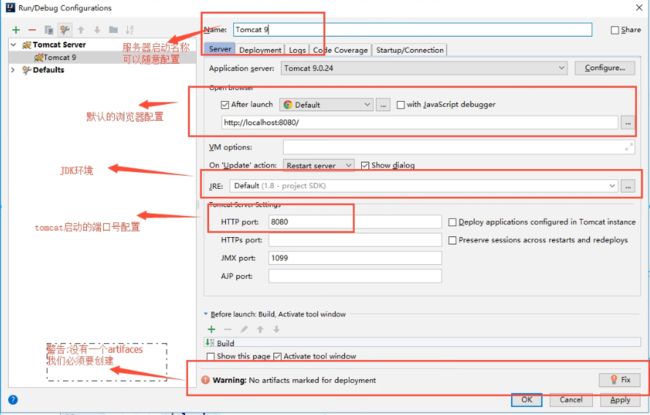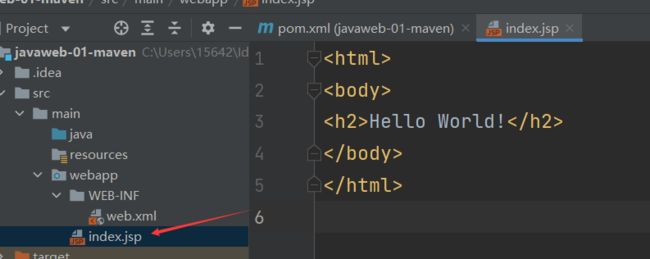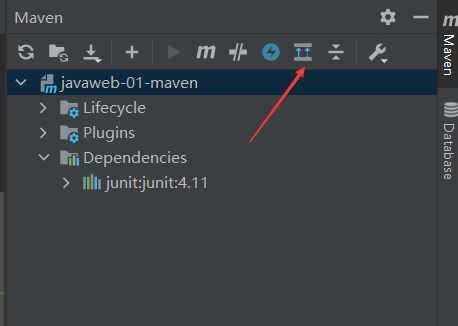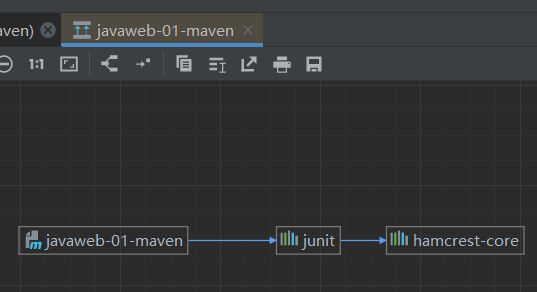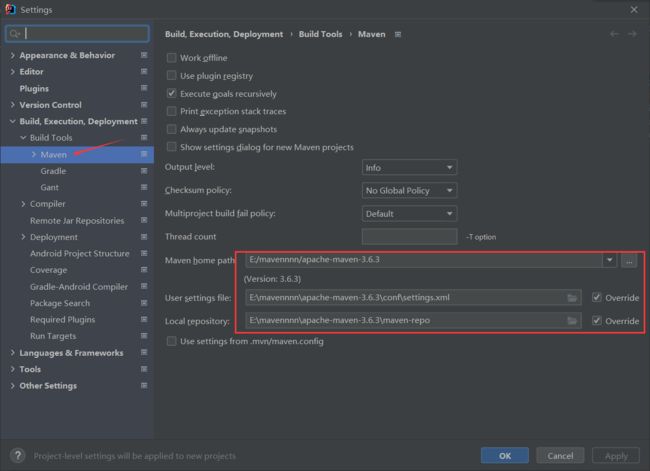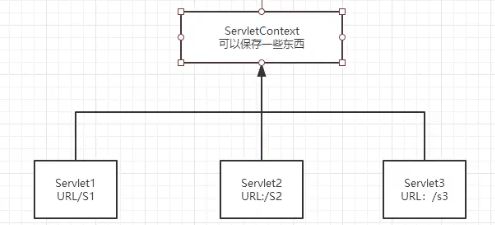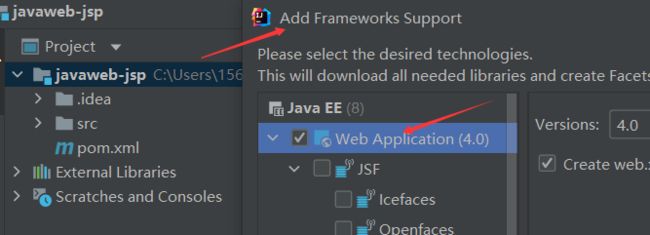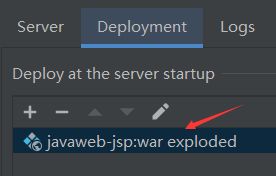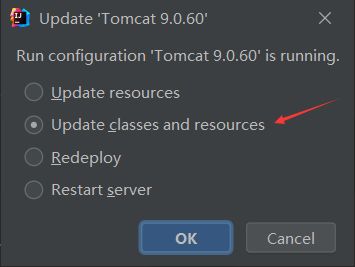【狂神】JavaWeb笔记
目录
- 1. 基本概念
-
- 1.1 前言
- 1.2 web应用程序
- 1.3 静态web
- 1.4 动态web
- 2. web服务器
-
- 2.1 技术讲解
- 2.2 web服务器
- 3. Tomcat
-
- 3.1 安装 tomcat
- 3.2 Tomcat启动和配置
- 3.3 配置
- 3.4 发布一个 web 网站
- 4. Http
-
- 4.1 什么是HTTP
- 4.2 两个时代
- 4.3 Http请求
- 4.4 Http响应
- 5. Maven
-
- 5.1 Maven项目架构管理工具
- 5.2 下载安装Maven
- 5.4 配置阿里云镜像
- 5.5 配置本地仓库
- 5.6 在IDEA中使用Maven
- 5.7 创建一个普通的Maven项目
- 5.8 标记文件夹功能
- 5.9 在 IDEA中配置Tomcat
- 5.10 pom文件
- 5.11 IDEA操作
- 5.12 解决遇到的问题
- 6. Servlet
-
- 6.1 Servlet简介
- 6.2 HelloServlet
- 6.3 Servlet原理
- 6.4 Mapping问题
- 6.5 ServletContext
- 6.6 HttpServletResponse
- 6.7 HttpServletRequest
- 7 Cookie、Session
-
- 7.1 会话
- 7.2 保存会话的两种技术
- 7.3 Cookie
- 7.4 Session(重点)
- 8. JSP
-
- 8.1 什么是JSP
- 8.2 JSP原理
- 8.3 JSP基础语法
- 8.4 JSP指令
- 8.5 九大内置对象
- 8.6 JSP标签、JSTL标签、EL表达式
- 9. JavaBean
- 10. MVC三层架构
-
- 10.1 早些年
- 10.2 MVC三层架构
- 11. Filter (重点)
- 12. 监听器
- 13. 过滤器、监听器常见应用
1. 基本概念
1.1 前言
web开发:
- web,网页的意思 ,例如 www.baidu.com
- 静态 web
- html,css
- 提供给所有人看的数据始终不会发生变化!
- 动态web
- 淘宝,几乎是所有的网站;
- 提供给所有人看的数据始终会发生变化,每个人在不同的时间,不同的地点看到的信息各不相同!
- 技术栈:Servlet/JSP,ASP,PHP
在Java中,动态 web 资源开发的技术统称为JavaWeb;
1.2 web应用程序
web应用程序:可以提供浏览器访问的程序;
- a.html、b.html…多个web资源,这些web资源可以被外界访问,对外界提供服务;
- 你们能访问到的任何一个页面或者资源,都存在于这个世界的某一个角落的计算机上。
- URL
- 这个统一的web资源会被放在同一个文件夹下,web应用程序–>Tomcat:服务器
- 一个web应用由多部分组成 (静态web,动态web)
- html,css,js
- jsp,servlet
- Java程序
- jar包
- 配置文件 (Properties)
web 应用程序编写完毕后,若想提供给外界访问:需要一个服务器来统一管理;
1.3 静态web
-
静态web存在的缺点
- Web页面无法动态更新,所有用户看到都是同一个页面
- 轮播图,点击特效:伪动态
- JavaScript [实际开发中,它用的最多]
- VBScript
- 它无法和数据库交互(数据无法持久化,用户无法交互)
- Web页面无法动态更新,所有用户看到都是同一个页面
1.4 动态web
页面会动态展示: “Web的页面展示的效果因人而异”;
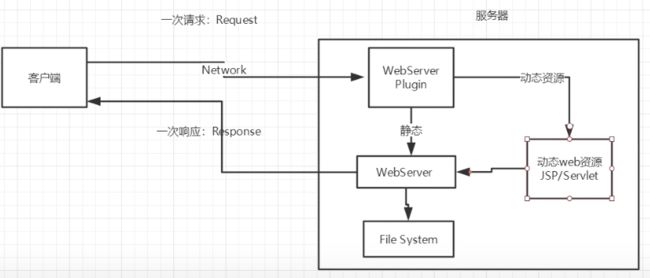
缺点:
- 假如服务器的动态web资源出现了错误,我们需要重新编写我们的后台程序,重新发布,这意味着停机维护;
优点:
2. web服务器
2.1 技术讲解
ASP:
-
微软:国内最早流行的就是ASP;
-
在HTML中嵌入了VB的脚本, ASP + COM;
-
在ASP开发中,基本一个页面都有几千行的业务代码,页面极其换乱
比如:
<h1>
<h1><h1>
<h1>
<h1>
<h1>
<h1>
<%
System.out.println("hello")
%>
<h1>
<h1>
<h1><h1>
<h1>
-
维护成本高!
-
ASP主要用 C#
-
Windows中用的 IIS 服务器
php:
- PHP开发速度很快,功能很强大,跨平台,代码很简单 (70%的网站在用 , WordPress)
- 无法承载大访问量的情况(局限性)
JSP/Servlet
B/S:浏览和服务器
C/S:客户端和服务器
- sun 公司主推的 B/S 架构
- 基于Java 语言的 (所有的大公司,或者一些开源的组件,都是用 Java 写的)
- 可以承载 三高 问题带来的影响;
- 语法像 ASP , 方便 ASP 转 JSP , 加强市场强度;
2.2 web服务器
服务器是一种被动的操作,用来处理用户的一些请求和给用户一些响应信息;
IIS:微软的,Windows中自带的,跑一些 ASP
Tomcat
Tomcat 服务器是一个免费的开放源代码的Web 应用服务器,属于轻量级应用服务器,在中小型系统和并发访问用户不是很多的场合下被普遍使用,是开发和调试JSP 程序的首选。对于一个Java初学web的人来说,它是最佳的选择
Tomcat 实际上运行JSP 页面和Servlet。
工作3-5年之后,可以尝试手写Tomcat服务器;
3. Tomcat
3.1 安装 tomcat
tomcat官网:http://tomcat.apache.org/
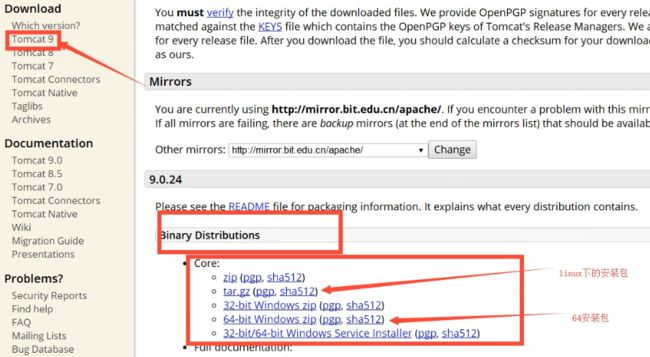
将下载的压缩包,解压即可使用
3.2 Tomcat启动和配置
文件夹作用:

启动、关闭Tomcat
bin 目录下,双击 startup.bat 文件,启动 Tomcat
访问测试:http://localhost:8080/
可能遇到的问题:
- Java环境变量没有配置
- 闪退问题:需要配置兼容性
- 乱码问题:配置文件中设置
3.3 配置
- tomcat的默认端口号为:8080
- mysql:3306
- http:80
- https:443
<Connector port="8080" protocol="HTTP/1.1"
connectionTimeout="20000"
redirectPort="8443" />
可以配置主机的名称
- 默认的主机名为:localhost->127.0.0.1
- 默认网站应用存放的位置为:webapps
高难度面试题:
请你谈谈网站是如何进行访问的!
-
输入一个域名;回车
-
检查本机的 C:\Windows\System32\drivers\etc\hosts配置文件下有没有这个域名映射;
- 有:直接返回该域名对应的 ip 地址,这个地址中,有我们需要访问的 web 程序,可以直接访问
- 没有:去 DNS 服务器找,找到的话就返回,找不到就返回找不到;
3.4 发布一个 web 网站
不会就先模仿
- 将自己写的网站,放到服务器(Tomcat) 中指定的 web 应用的文件夹(webapps)下,就可以访问了
网站应该有的结构
--webapps :Tomcat服务器的web目录
-ROOT
-kuangstudy :网站的目录名
- WEB-INF
-classes : java程序
-lib:web应用所依赖的jar包
-web.xml :网站配置文件
- index.html 默认的首页
- static
-css
-style.css
-js
-img
-.....
HTTP协议 : 面试
Maven:构建工具
- Maven安装包
Servlet 入门
- HelloWorld!
- Servlet配置
- 原理
4. Http
4.1 什么是HTTP
HTTP(超文本传输协议)是一个简单的请求-响应协议,它通常运行在TCP之上。
- 文本:html,字符串, ….
- 超文本:图片,音乐,视频,定位,地图…….
- 默认端口:80
Https:安全的
- 默认端口:443
4.2 两个时代
-
http1.0
- HTTP/1.0:客户端可以与web服务器连接后,只能获得一个web资源,断开连接
-
http2.0
- HTTP/1.1:客户端可以与web服务器连接后,可以获得多个web资源。
4.3 Http请求
- 客户端—发请求(Request)—服务器
百度:
Request URL:https://www.baidu.com/ 请求地址
Request Method:GET get方法/post方法
Status Code:200 OK 状态码:200
Remote(远程) Address:14.215.177.39:443 IP地址+端口
Accept:text/html
Accept-Encoding:gzip, deflate, br
Accept-Language:zh-CN,zh;q=0.9 语言
Cache-Control:max-age=0
Connection:keep-alive
1、请求行
- 请求行中的请求方式:GET
- 请求方式:Get,Post,HEAD,DELETE,PUT,TRACT…
- get:请求能够携带的参数比较少,大小有限制,会在浏览器的URL地址栏显示数据内容,不安全,但高效
- post:请求能够携带的参数没有限制,大小没有限制,不会在浏览器的URL地址栏显示数据内容,安全,但不高效。
2、消息头
Accept:告诉浏览器,它所支持的数据类型
Accept-Encoding:支持哪种编码格式 GBK UTF-8 GB2312 ISO8859-1
Accept-Language:告诉浏览器,它的语言环境
Cache-Control:缓存控制
Connection:告诉浏览器,请求完成是断开还是保持连接
HOST:主机..../.
4.4 Http响应
- 服务器—响应-----客户端
百度:
Cache-Control:private 缓存控制
Connection:Keep-Alive 连接
Content-Encoding:gzip 编码
Content-Type:text/html 类型
1、响应体
Accept:告诉浏览器,它所支持的数据类型
Accept-Encoding:支持哪种编码格式 GBK UTF-8 GB2312 ISO8859-1
Accept-Language:告诉浏览器,它的语言环境
Cache-Control:缓存控制
Connection:告诉浏览器,请求完成是断开还是保持连接
HOST:主机..../.
Refresh:告诉客户端,多久刷新一次;
Location:让网页重新定位;
2、响应状态码
200:请求响应成功 200
3xx:请求重定向
- 重定向:你重新到我给你新位置去;
4xx:找不到资源 404
- 资源不存在;
5xx:服务器代码错误 500 ,502:网关错误
常见面试题:
当你的浏览器中地址栏输入地址并回车的一瞬间到页面能够展示回来,经历了什么?
5. Maven
maven一定要下载和 IDEA 版本兼容的,一般不要选最新的!!!
maven 各版本下载地址:https://dlcdn.apache.org/maven/maven-3/
点进去,binaries/ 目录下就可以下载
我为什么要学习这个技术?
-
在Javaweb开发中,需要使用大量的 jar 包,我们手动去导入;
-
如何能够让一个东西自动帮我导入和配置这个jar包。
由此,Maven诞生了!
5.1 Maven项目架构管理工具
我们目前用它来就是方便导入 jar 包的!
Maven 的核心思想:约定大于配置
- 有约束,不要去违反。
Maven会规定好你该如何去编写我们的 Java 代码,必须要按照这个规范来;
5.2 下载安装Maven
官网:https://maven.apache.org/

下载完成后,解压即可;
小狂神友情建议:电脑上的所有环境都放在一个文件夹下,方便管理;
5.3 配置环境变量
在我们的系统环境变量中
配置如下配置:
- M2_HOME :maven目录下的 bin 目录
- MAVEN_HOME :maven 的目录
- 在系统的 path 中配置 %MAVEN_HOME%\bin
测试 Maven 是否安装成功,保证必须配置完毕!打开 mcd,输入 mvn -version
5.4 配置阿里云镜像
- 镜像:mirrors
- 作用:加速我们的下载
- 国内建议使用阿里云的镜像
在 settings.xml 中的 mirrors 标签内加入以下代码(建议使用 notepad++打开该文件,这样可以区分注释,记事本分不清注释和代码…)

<mirror>
<id>nexus-aliyun</id>
<mirrorOf>*,!jeecg,!jeecg-snapshots</mirrorOf>
<name>Nexus aliyun</name>
<url>http://maven.aliyun.com/nexus/content/groups/public</url>
</mirror>
5.5 配置本地仓库
建立一个本地仓库: localRepository
IDEA有自带的,但是自己配一个本地的更好
在 maven 安装目录下新建文件夹 “maven-repo”

在 conf 目录下的配置文件 settings.xml 文件中进行配置

5.6 在IDEA中使用Maven

这两个 Bundled 是 IDEA 自带的 Maven,我们使用自己下载的 Maven


- 等待项目初始化完毕
- 观察maven仓库中多了什么东西?
5.7 创建一个普通的Maven项目
前面我们使用了模板创建的 Maven 项目,现在不使用

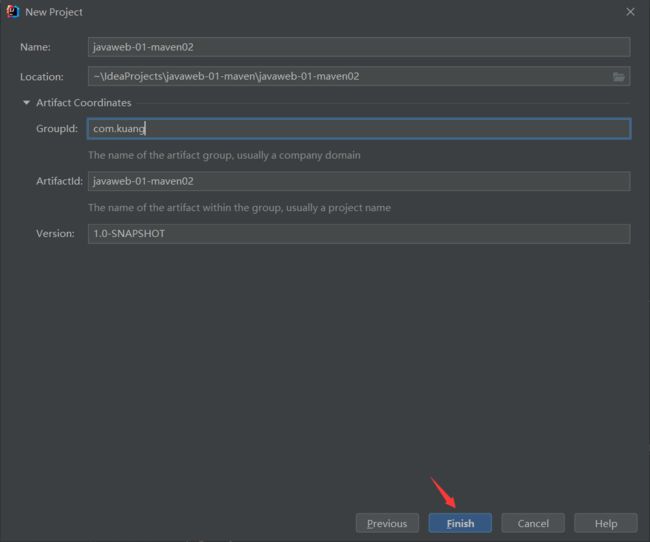
一个干净的 Maven 项目就创建完了!

下面这个只有在Web应用下才会有!(第一个Maven我们用了模板创建的,会自动生成这个)
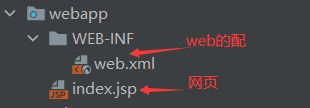
5.8 标记文件夹功能
方式1:
在含有 webapp 目录的 Maven 项目中,在 main 目录下新建 “java” 和 “resources” 目录,选中 “java” 和 “resources” ,单击右键,并把它们分别标记为 源码目录 和 资源目录

方式2:

5.9 在 IDEA中配置Tomcat
必须要的配置:为什么会有这个问题:我们访问一个网站,需要指定一个文件夹名字;


假如 “Application context” 处写了一个 “/”,它就会访问 localhost:8080/
假如 “Application context” 处写了一个 “/kaung”,它就会访问 localhost:8080/kuang
右上角启动 Tomcat 服务器

浏览器效果:

这里访问到的 Helloworld 就是我们默认的 index.jsp 中的内容
5.10 pom文件
<project xmlns="http://maven.apache.org/POM/4.0.0" xmlns:xsi="http://www.w3.org/2001/XMLSchema-instance"
xsi:schemaLocation="http://maven.apache.org/POM/4.0.0 http://maven.apache.org/xsd/maven-4.0.0.xsd">
<modelVersion>4.0.0modelVersion>
<groupId>com.kuanggroupId>
<artifactId>javaweb-01-mavenartifactId>
<version>1.0-SNAPSHOTversion>
<packaging>warpackaging>
<properties>
<project.build.sourceEncoding>UTF-8project.build.sourceEncoding>
<maven.compiler.source>1.8maven.compiler.source>
<maven.compiler.target>1.8maven.compiler.target>
properties>
<dependencies>
<dependency>
<groupId>junitgroupId>
<artifactId>junitartifactId>
<version>4.11version>
dependency>
dependencies>
<build>
<finalName>javaweb-01-mavenfinalName>
<pluginManagement>
<plugins>
<plugin>
<artifactId>maven-clean-pluginartifactId>
<version>3.1.0version>
plugin>
<plugin>
<artifactId>maven-resources-pluginartifactId>
<version>3.0.2version>
plugin>
<plugin>
<artifactId>maven-compiler-pluginartifactId>
<version>3.8.0version>
plugin>
<plugin>
<artifactId>maven-surefire-pluginartifactId>
<version>2.22.1version>
plugin>
<plugin>
<artifactId>maven-war-pluginartifactId>
<version>3.2.2version>
plugin>
<plugin>
<artifactId>maven-install-pluginartifactId>
<version>2.5.2version>
plugin>
<plugin>
<artifactId>maven-deploy-pluginartifactId>
<version>2.8.2version>
plugin>
plugins>
pluginManagement>
build>
project>

maven 由于他的约定大于配置,我们之后可以能遇到我们写的配置文件,无法被导出或者生效的问题,解决方案:
pom.xml
<build>
<resources>
<resource>
<directory>src/main/resourcesdirectory>
<includes>
<include>**/*.propertiesinclude>
<include>**/*.xmlinclude>
includes>
<filtering>truefiltering>
resource>
<resource>
<directory>src/main/javadirectory>
<includes>
<include>**/*.propertiesinclude>
<include>**/*.xmlinclude>
includes>
<filtering>truefiltering>
resource>
resources>
build>
5.11 IDEA操作
5.12 解决遇到的问题
6. Servlet
6.1 Servlet简介
- Servlet就是sun公司开发动态web的一门技术
- Sun在这些API中提供一个接口叫做:Servlet,如果你想开发一个Servlet程序,只需要完成两个小步骤:
- 编写一个类,实现Servlet接口
- 把开发好的Java类部署到web服务器中。
把实现了Servlet接口的Java程序叫做,Servlet
6.2 HelloServlet
Serlvet 接口 Sun 公司有两个默认的实现类:HttpServlet,GenericServlet;
我们继承就可以使用
- 构建一个普通的Maven项目 “javaweb-02-servlet”,删掉里面的 src 目录,以后我们的学习就在这个项目里面建立 Moudel;这个空的工程就是Maven主工程,将主要的依赖导在主工程中,以后新建子工程就不用重复导了;
(1)在 pom.xml 中添加 jsp 和 servlet 依赖
<dependencies>
<dependency>
<groupId>javax.servletgroupId>
<artifactId>javax.servlet-apiartifactId>
<version>4.0.1version>
dependency>
<dependency>
<groupId>javax.servlet.jspgroupId>
<artifactId>jsp-apiartifactId>
<version>2.2version>
dependency>
dependencies>
<web-app xmlns="http://xmlns.jcp.org/xml/ns/javaee"
xmlns:xsi="http://www.w3.org/2001/XMLSchema-instance"
xsi:schemaLocation="http://xmlns.jcp.org/xml/ns/javaee
http://xmlns.jcp.org/xml/ns/javaee/web-app_4_0.xsd"
version="4.0"
metadata-complete="true">
web-app>
- 编写一个Servlet程序
在 java 目录下新建包名 com.kuang.servlet,包下新建 HelloServlet.java
(1)编写一个普通类
(2)实现Servlet接口,这里我们直接继承HttpServlet
package com.kuang.servlet;
import javax.servlet.ServletException;
import javax.servlet.http.HttpServlet;
import javax.servlet.http.HttpServletRequest;
import javax.servlet.http.HttpServletResponse;
import java.io.IOException;
import java.io.PrintWriter;
public class HelloServlet extends HttpServlet {
//由于get或者post只是请求实现的不同方式,可以相互调用,业务逻辑都一样;
@Override
protected void doGet(HttpServletRequest req, HttpServletResponse resp) throws ServletException, IOException {
//ServletOutputStream outputStream = resp.getOutputStream();
PrintWriter writer = resp.getWriter(); //响应流
writer.print("Hello,Servlet");
}
@Override
protected void doPost(HttpServletRequest req, HttpServletResponse resp) throws ServletException, IOException {
doGet(req, resp);
}
}
(3)编写Servlet的映射
为什么需要映射:我们写的是 JAVA 程序,但是要通过浏览器访问,而浏览器需要连接web 服务器,所以我们需要再 web 服务中注册我们写的 Servlet,还需给他一个浏览器能够访问的路径;
webapp–WEB-INF下的 web.xml 中
<servlet>
<servlet-name>helloservlet-name>
<servlet-class>com.kuang.servlet.HelloServletservlet-class>
servlet>
<servlet-mapping>
<servlet-name>helloservlet-name>
<url-pattern>/hellourl-pattern>
servlet-mapping>
-
配置Tomcat
注意:配置项目发布的路径就可以了 -
启动测试,OK!
6.3 Servlet原理
Servlet 是由 Web 服务器调用,web 服务器在收到浏览器请求之后,会:
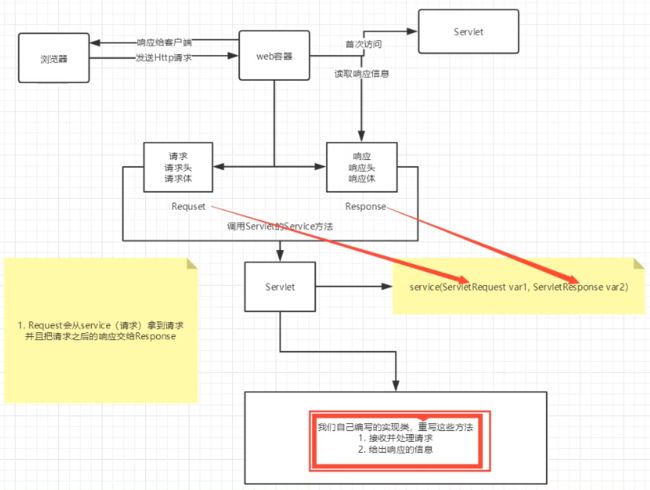
6.4 Mapping问题
- 一个 Servlet 可以指定一个映射路径
<servlet-mapping>
<servlet-name>helloservlet-name>
<url-pattern>/hellourl-pattern>
servlet-mapping>
- 一个Servlet可以指定多个映射路径
这样,输入 http://localhost:8080/hello2 ~ http://localhost:8080/hello4,都会指向同一个 Servlet 类
<servlet-mapping>
<servlet-name>helloservlet-name>
<url-pattern>/hellourl-pattern>
servlet-mapping>
<servlet-mapping>
<servlet-name>helloservlet-name>
<url-pattern>/hello2url-pattern>
servlet-mapping>
<servlet-mapping>
<servlet-name>helloservlet-name>
<url-pattern>/hello3url-pattern>
servlet-mapping>
<servlet-mapping>
<servlet-name>helloservlet-name>
<url-pattern>/hello4url-pattern>
servlet-mapping>
<servlet-mapping>
<servlet-name>helloservlet-name>
<url-pattern>/hello5url-pattern>
servlet-mapping>
- 一个 Servlet 可以指定通用映射路径
<servlet-mapping>
<servlet-name>helloservlet-name>
<url-pattern>/hello/*url-pattern>
servlet-mapping>
- 默认请求路径
<servlet-mapping>
<servlet-name>helloservlet-name>
<url-pattern>/*url-pattern>
servlet-mapping>
- 指定一些后缀或者前缀等等….
访问 http://localhost:8080/sadas.qinjiang 可以成功跳转
红字部分对应下面代码中的 * ,指的是匹配所有,所以红字部分可以胡乱写
<servlet-mapping>
<servlet-name>helloservlet-name>
<url-pattern>*.qinjiangurl-pattern>
servlet-mapping>
- 优先级问题
指定了固有的映射路径优先级最高,如果找不到就会走默认的处理请求;
/hello 也属于 /* 的范围,但访问 http://localhost:8080/hello 时,并不会跳转到 error,因为优先级不同
<servlet>
<servlet-name>errorservlet-name>
<servlet-class>com.kuang.servlet.ErrorServletservlet-class>
servlet>
<servlet-mapping>
<servlet-name>helloservlet-name>
<url-pattern>/hellourl-pattern>
servlet-mapping>
<servlet-mapping>
<servlet-name>errorservlet-name>
<url-pattern>/*url-pattern>
servlet-mapping>
新建子模块 servlet-02,当我们要启动服务器时,记得一个项目打包一次就行了
删掉 servlet-01的

加入 servlet-02 的


这样做的目的是,如果不删除原来的,那服务器每次都会将所有的进行打包,会变慢,而我们并不需要 servlet-01 了,所以删掉就行
如果发现没有 servlet-02:war,那就刷新一下 Maven,等待下载完就有了

6.5 ServletContext
web 容器在启动的时候,它会为每个 web 程序都创建一个对应的 ServletContext 对象,它代表了当前的 web 应用;
1、共享数据
我在这个 Servlet 中保存的数据,可以在另外一个 servlet 中拿到;
使用 HelloServlet 类往 ServletContext 中存一些数据
public class HelloServlet extends HttpServlet {
@Override
protected void doGet(HttpServletRequest req, HttpServletResponse resp) throws ServletException, IOException {
//this.getInitParameter() 获得初始化参数
//this.getServletConfig() 获得Servlet配置
//this.getServletContext() 获得Servlet上下文
ServletContext context = this.getServletContext();
String username = "秦疆"; //数据
context.setAttribute("username",username); //将一个数据保存在了ServletContext中,名字为:username ,值 username
}
}
使用 GetServlet 类获取前面存的数据
public class GetServlet extends HttpServlet {
@Override
protected void doGet(HttpServletRequest req, HttpServletResponse resp) throws ServletException, IOException {
ServletContext context = this.getServletContext();
String username = (String) context.getAttribute("username");
resp.setContentType("text/html");
resp.setCharacterEncoding("utf-8");
resp.getWriter().print("名字:"+username);
}
@Override
protected void doPost(HttpServletRequest req, HttpServletResponse resp) throws ServletException, IOException {
doGet(req, resp);
}
}
别忘了在 web.xml 中注册并添加映射
<servlet>
<servlet-name>helloservlet-name>
<servlet-class>com.kuang.servlet.HelloServletservlet-class>
servlet>
<servlet-mapping>
<servlet-name>helloservlet-name>
<url-pattern>/hellourl-pattern>
servlet-mapping>
<servlet>
<servlet-name>getcservlet-name>
<servlet-class>com.kuang.servlet.GetServletservlet-class>
servlet>
<servlet-mapping>
<servlet-name>getcservlet-name>
<url-pattern>/getcurl-pattern>
servlet-mapping>
在浏览器中先访问 hello,后访问 getc,发现可以拿到存的数据!
2、获取初始化参数
web.xml中配置初始化参数
<context-param>
<param-name>urlparam-name>
<param-value>jdbc:mysql://localhost:3306/mybatisparam-value>
context-param>
配置完,就可以去获得
public class servletDemo03 extends HttpServlet {
@Override
protected void doGet(HttpServletRequest req, HttpServletResponse resp) throws ServletException, IOException {
ServletContext context = this.getServletContext();
String url = context.getInitParameter("url");
resp.getWriter().print(url);
}
@Override
protected void doPost(HttpServletRequest req, HttpServletResponse resp) throws ServletException, IOException {
doGet(req, resp);
}
}
<servlet>
<servlet-name>gpservlet-name>
<servlet-class>com.kuang.servlet.servletDemo03servlet-class>
servlet>
<servlet-mapping>
<servlet-name>gpservlet-name>
<url-pattern>/gpurl-pattern>
servlet-mapping>
访问 http://localhost:8080/gp,成功输出 jdbc:mysql://localhost:3306/mybatis
3、请求转发
public class servletDemo04 extends HttpServlet {
@Override
protected void doGet(HttpServletRequest req, HttpServletResponse resp) throws ServletException, IOException {
ServletContext context = this.getServletContext();
System.out.println("进入了ServletDemo04");
//RequestDispatcher requestDispatcher = context.getRequestDispatcher("/gp"); //转发的请求路径
//requestDispatcher.forward(req,resp); //调用forward实现请求转发;
context.getRequestDispatcher("/gp").forward(req,resp);
}
@Override
protected void doPost(HttpServletRequest req, HttpServletResponse resp) throws ServletException, IOException {
doGet(req, resp);
}
}
注册并添加映射
<servlet>
<servlet-name>sd4servlet-name>
<servlet-class>com.kuang.servlet.servletDemo04servlet-class>
servlet>
<servlet-mapping>
<servlet-name>sd4servlet-name>
<url-pattern>/sd4url-pattern>
servlet-mapping>
访问 http://localhost:8080/sd4,成功输出 gp 的内容,转发的时候路径不会变,还是 http://localhost:8080/sd4,只是展示了 gp 的内容
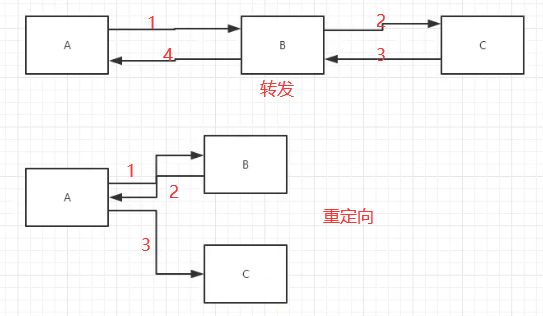
4、读取资源文件
需要用到 Properties 类
- 在 java目录下新建 dbproperties
- 在 resources 目录下新建 db.properties
发现:都被打包到了同一个路径下:classes,我们俗称这个路径为 classpath:
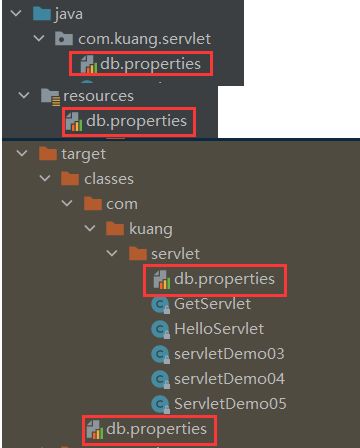
思路:需要一个文件流;
public class ServletDemo05 extends HttpServlet {
@Override
protected void doGet(HttpServletRequest req, HttpServletResponse resp) throws ServletException, IOException {
InputStream is = this.getServletContext().getResourceAsStream("/WEB-INF/classes/com/kuang/servlet/db.properties");
Properties prop = new Properties();
prop.load(is);
String user = prop.getProperty("username");
String pwd = prop.getProperty("password");
resp.getWriter().print(user+":"+pwd);
}
@Override
protected void doPost(HttpServletRequest req, HttpServletResponse resp) throws ServletException, IOException {
doGet(req, resp);
}
}
web.xml 中注册
<servlet>
<servlet-name>sd5servlet-name>
<servlet-class>com.kuang.servlet.ServletDemo05servlet-class>
servlet>
<servlet-mapping>
<servlet-name>sd5servlet-name>
<url-pattern>/sd5url-pattern>
servlet-mapping>
在当前子模块的 pom.xml 中添加如下配置
<build>
<resources>
<resource>
<directory>src/main/resourcesdirectory>
<includes>
<include>**/*.propertiesinclude>
<include>**/*.xmlinclude>
includes>
<filtering>truefiltering>
resource>
<resource>
<directory>src/main/javadirectory>
<includes>
<include>**/*.propertiesinclude>
<include>**/*.xmlinclude>
includes>
<filtering>truefiltering>
resource>
resources>
build>
如果报了 500 错误,就 clean 一下,再重启服务器:

测试访问结果
6.6 HttpServletResponse
web服务器接收到客户端的http请求,针对这个请求,分别创建一个代表请求的HttpServletRequest 对象,代表响应的一个 HttpServletResponse;
- 如果要获取客户端请求过来的参数:找 HttpServletRequest
- 如果要给客户端响应一些信息:找 HttpServletResponse
1、简单分类
负责向浏览器发送数据的方法
ServletOutputStream getOutputStream() throws IOException;
PrintWriter getWriter() throws IOException;
负责向浏览器发送响应头的方法
void setCharacterEncoding(String var1);
void setContentLength(int var1);
void setContentLengthLong(long var1);
void setContentType(String var1);
void setDateHeader(String var1, long var2);
void addDateHeader(String var1, long var2);
void setHeader(String var1, String var2);
void addHeader(String var1, String var2);
void setIntHeader(String var1, int var2);
void addIntHeader(String var1, int var2);
响应的状态码
int SC_CONTINUE = 100;
int SC_SWITCHING_PROTOCOLS = 101;
int SC_OK = 200;
int SC_CREATED = 201;
int SC_ACCEPTED = 202;
int SC_NON_AUTHORITATIVE_INFORMATION = 203;
int SC_NO_CONTENT = 204;
int SC_RESET_CONTENT = 205;
int SC_PARTIAL_CONTENT = 206;
int SC_MULTIPLE_CHOICES = 300;
int SC_MOVED_PERMANENTLY = 301;
int SC_MOVED_TEMPORARILY = 302;
int SC_FOUND = 302;
int SC_SEE_OTHER = 303;
int SC_NOT_MODIFIED = 304;
int SC_USE_PROXY = 305;
int SC_TEMPORARY_REDIRECT = 307;
int SC_BAD_REQUEST = 400;
int SC_UNAUTHORIZED = 401;
int SC_PAYMENT_REQUIRED = 402;
int SC_FORBIDDEN = 403;
int SC_NOT_FOUND = 404;
int SC_METHOD_NOT_ALLOWED = 405;
int SC_NOT_ACCEPTABLE = 406;
int SC_PROXY_AUTHENTICATION_REQUIRED = 407;
int SC_REQUEST_TIMEOUT = 408;
int SC_CONFLICT = 409;
int SC_GONE = 410;
int SC_LENGTH_REQUIRED = 411;
int SC_PRECONDITION_FAILED = 412;
int SC_REQUEST_ENTITY_TOO_LARGE = 413;
int SC_REQUEST_URI_TOO_LONG = 414;
int SC_UNSUPPORTED_MEDIA_TYPE = 415;
int SC_REQUESTED_RANGE_NOT_SATISFIABLE = 416;
int SC_EXPECTATION_FAILED = 417;
int SC_INTERNAL_SERVER_ERROR = 500;
int SC_NOT_IMPLEMENTED = 501;
int SC_BAD_GATEWAY = 502;
int SC_SERVICE_UNAVAILABLE = 503;
int SC_GATEWAY_TIMEOUT = 504;
int SC_HTTP_VERSION_NOT_SUPPORTED = 505;
2、下载文件
- 向浏览器输出消息 (一直在讲,就不说了)
- 下载文件
- 要获取下载文件的路径
- 下载的文件名是啥?
- 设置想办法让浏览器能够支持下载我们需要的东西
- 获取下载文件的输入流
- 创建缓冲区
- 获取 OutputStream 对象
- 将 FileOutputStream 流写入到 buffer 缓冲区
- 使用 OutputStream 将缓冲区中的数据输出到客户端!
新建 Module—“response”,新建 java 和 resources 目录并进行标记,将 web.xml 更新为:
<web-app xmlns="http://xmlns.jcp.org/xml/ns/javaee"
xmlns:xsi="http://www.w3.org/2001/XMLSchema-instance"
xsi:schemaLocation="http://xmlns.jcp.org/xml/ns/javaee
http://xmlns.jcp.org/xml/ns/javaee/web-app_4_0.xsd"
version="4.0"
metadata-complete="true">
web-app>
新建 FileServlet 类
public class FileServlet extends HttpServlet {
@Override
protected void doGet(HttpServletRequest req, HttpServletResponse resp) throws ServletException, IOException {
// 1. 要获取下载文件的路径
String realPath = "C:/Users/15642/Pictures/裁员.jpg";
System.out.println("下载文件的路径:"+ realPath);
// 2. 下载的文件名是啥?
String fileName = realPath.substring(realPath.lastIndexOf("/") + 1);
// 3. 设置想办法让浏览器能够支持(Content-Disposition)下载我们需要的东西,中文文件名URLEncoder.encode编码,否则有可能乱码
resp.setHeader("Content-Disposition","attachment;filename="+ URLEncoder.encode(fileName,"UTF-8"));
// 4. 获取下载文件的输入流
FileInputStream in = new FileInputStream(realPath);
// 5. 创建缓冲区
int len = 0;
byte[] buffer = new byte[1024];
// 6. 获取OutputStream对象
ServletOutputStream out = resp.getOutputStream();
// 7. 将FileOutputStream流写入到buffer缓冲区,使用OutputStream将缓冲区中的数据输出到客户端!
while ((len=in.read(buffer)) > 0){
out.write(buffer,0,len);
}
in.close();
out.close();
}
@Override
protected void doPost(HttpServletRequest req, HttpServletResponse resp) throws ServletException, IOException {
super.doPost(req, resp);
}
}
去 web.xml 注册
<servlet>
<servlet-name>filedownservlet-name>
<servlet-class>com.kuang.servlet.FileServletservlet-class>
servlet>
<servlet-mapping>
<servlet-name>filedownservlet-name>
<url-pattern>/filedownurl-pattern>
servlet-mapping>
更改 Tomat 的 Deployment,换成 response:war

访问 localhost:8080/filedown,成功下载图片!

3、验证码功能
验证怎么来的?
- 前端实现
- 后端实现,需要用到 Java 的图片类,生产一个图片
我们用 Java 自己写个图片,新建 ImageServlet 类
package com.kuang.servlet;
import javax.imageio.ImageIO;
import javax.servlet.ServletException;
import javax.servlet.http.HttpServlet;
import javax.servlet.http.HttpServletRequest;
import javax.servlet.http.HttpServletResponse;
import java.awt.*;
import java.awt.image.BufferedImage;
import java.io.IOException;
import java.util.Random;
public class ImageServlet extends HttpServlet {
@Override
protected void doGet(HttpServletRequest req, HttpServletResponse resp) throws ServletException, IOException {
//如何让浏览器3秒自动刷新一次;
resp.setHeader("refresh","3");
//在内存中创建一个图片
BufferedImage image = new BufferedImage(80,20,BufferedImage.TYPE_INT_RGB);
//得到图片
Graphics2D g = (Graphics2D) image.getGraphics(); //笔
//设置图片的背景颜色
g.setColor(Color.white);
g.fillRect(0,0,80,20);
//给图片写数据
g.setColor(Color.BLUE);
g.setFont(new Font(null,Font.BOLD,20));
g.drawString(makeNum(),0,20);
//告诉浏览器,这个请求用图片的方式打开
resp.setContentType("image/jpeg");
//网站存在缓存,不让浏览器缓存
resp.setDateHeader("expires",-1);
//缓存控制:不缓存
resp.setHeader("Cache-Control","no-cache");
resp.setHeader("Pragma","no-cache");
//把图片写给浏览器
ImageIO.write(image,"jpg", resp.getOutputStream());
}
//生成随机数
private String makeNum(){
Random random = new Random();
String num = random.nextInt(9999999) + "";
StringBuffer sb = new StringBuffer();
for (int i = 0; i < 7 - num.length() ; i++) {//如果num是两位数
sb.append("0");//那这里sb就会是五位数
}
num = sb.toString() + num;//最后总能保证num是七位数
return num;
}
@Override
protected void doPost(HttpServletRequest req, HttpServletResponse resp) throws ServletException, IOException {
doGet(req, resp);
}
}
去 web.xml 注册
<servlet>
<servlet-name>imageservlet-name>
<servlet-class>com.kuang.servlet.ImageServletservlet-class>
servlet>
<servlet-mapping>
<servlet-name>imageservlet-name>
<url-pattern>/imageurl-pattern>
servlet-mapping>
访问 http://localhost:8080/image,成功出现验证码,并且 3 秒刷新一次

4、实现重定向
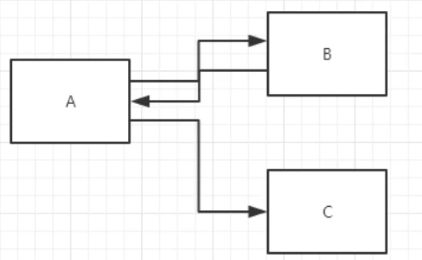
一个web资源 (B) 收到客户端A请求后,B 他会通知 A 客户端去访问另外一个 web 资源C,这个过程叫重定向
常见场景:
- 用户登录
void sendRedirect(String var1) throws IOException;
新建 RedirectServlet 类
public class RedirectServlet extends HttpServlet {
@Override
protected void doGet(HttpServletRequest req, HttpServletResponse resp) throws ServletException, IOException {
/**
resp.setHeader("Location","/image");
resp.setStatus(302);
*/
resp.sendRedirect("/image");//重定向就是做了上面两步
}
@Override
protected void doPost(HttpServletRequest req, HttpServletResponse resp) throws ServletException, IOException {
doGet(req, resp);
}
}
注册 web.xml
<servlet>
<servlet-name>RedirectServletservlet-name>
<servlet-class>com.kuang.servlet.RedirectServletservlet-class>
servlet>
<servlet-mapping>
<servlet-name>RedirectServletservlet-name>
<url-pattern>/redurl-pattern>
servlet-mapping>
测试:网址成功跳转!
面试题:请你聊聊重定向和转发的区别?
相同点
- 页面都会实现跳转
不同点
- 请求转发的时候,url 不会产生变化
- 重定向时候,url 地址栏会发生变化;
新建 RequestTest 类
public class RequestTest extends HttpServlet {
@Override
protected void doGet(HttpServletRequest req, HttpServletResponse resp) throws ServletException, IOException {
//处理请求
String username = req.getParameter("username");
String password = req.getParameter("password");
System.out.println(username+":"+password);
//重定向时候一定要注意,路径问题,否则404;
resp.sendRedirect("/success.jsp");
}
@Override
protected void doPost(HttpServletRequest req, HttpServletResponse resp) throws ServletException, IOException {
doGet(req, resp);
}
}
注册 web.xml
<servlet>
<servlet-name>RequestTestservlet-name>
<servlet-class>com.kuang.servlet.RequestTestservlet-class>
servlet>
<servlet-mapping>
<servlet-name>RequestTestservlet-name>
<url-pattern>/loginurl-pattern>
servlet-mapping>
编辑 webapp 目录下的 index.jsp
点击 “提交” 后会提交到 /login
<%@ page pageEncoding="UTF-8"%>
<html>
<body>
<h2>Hello World!h2>
<%--这里提交的路径,需要寻找到项目的路径--%>
<%--${pageContext.request.contextPath}代表当前项目--%>
<form action="${pageContext.request.contextPath}/login" method="get">
用户名:<input type="text" name="username"> <br>
密码:<input type="password" name="password"> <br>
<input type="submit">
form>
body>
html>
在 webapp 目录下新建 success.jsp(即登录后的要跳转的页面)
<%@ page contentType="text/html;charset=UTF-8" language="java" %>
<html>
<head>
<title>Titletitle>
head>
<body>
<h1>Successh1>
body>
html>
6.7 HttpServletRequest
HttpServletRequest 代表客户端的请求,用户通过 Http 协议访问服务器,HTTP 请求中的所有信息会被封装到 HttpServletRequest ,通过这个 HttpServletRequest 的方法,获得客户端的所有信息;


request 的作用:获取参数,请求转发
新建 Module (模板 Maven 项目) —“request”
web.xml 换成最新版的,main 目录下新建 java 和 resources 并进行标识
<web-app xmlns="http://xmlns.jcp.org/xml/ns/javaee"
xmlns:xsi="http://www.w3.org/2001/XMLSchema-instance"
xsi:schemaLocation="http://xmlns.jcp.org/xml/ns/javaee
http://xmlns.jcp.org/xml/ns/javaee/web-app_4_0.xsd"
version="4.0"
metadata-complete="true">
web-app>
更改 index.jsp 的内容
<%@ page contentType="text/html;charset=UTF-8" language="java" %>
<html>
<head>
<title>登陆title>
head>
<body>
<h1>登陆h1>
<div style="text-align: center">
<%--这里表单表示的意思:以post方式提交表单,提交到web.xml中的/login--%>
<form action="${pageContext.request.contextPath}/login" method="post">
用户名:<input type="text" name="username"> <br>
密码:<input type="password" name="password"> <br>
爱好:
<input type="checkbox" name="hobbies" value="泡妞">泡妞
<input type="checkbox" name="hobbies" value="写代码">写代码
<input type="checkbox" name="hobbies" value="唱歌">唱歌
<input type="checkbox" name="hobbies" value="电影">电影
<br>
<input type="submit">
form>
div>
body>
html>
在 webapp 下新建 success.jsp
<%@ page contentType="text/html;charset=UTF-8" language="java" %>
<html>
<head>
<title>Titletitle>
head>
<body>
<h1>Successh1>
body>
html>
新建 LoginServlet 类
public class LoginServlet extends HttpServlet {
@Override
protected void doGet(HttpServletRequest req, HttpServletResponse resp) throws ServletException, IOException {
//处理后台接收中文乱码问题
req.setCharacterEncoding("utf-8");
resp.setCharacterEncoding("utf-8");
String username = req.getParameter("username");
String password = req.getParameter("password");
String[] hobbys = req.getParameterValues("hobbies");//参数hobbies有多个值
System.out.println("=============================");
//后台接收中文乱码问题
System.out.println(username);
System.out.println(password);
System.out.println(Arrays.toString(hobbys));
System.out.println("=============================");
System.out.println(req.getContextPath());
//通过请求转发
//这里的 / 代表当前的web应用
req.getRequestDispatcher("/success.jsp").forward(req,resp);
}
@Override
protected void doPost(HttpServletRequest req, HttpServletResponse resp) throws ServletException, IOException {
doGet(req, resp);
}
}
注册 web.xml
<servlet>
<servlet-name>LoginServletservlet-name>
<servlet-class>com.kuang.servlet.LoginServletservlet-class>
servlet>
<servlet-mapping>
<servlet-name>LoginServletservlet-name>
<url-pattern>/loginurl-pattern>
servlet-mapping>
更新 Tomcat 配置(Deployment 换成 request:war),测试结果。

7 Cookie、Session
新建 Module (模板 Maven 项目) —“session-cookie”
web.xml 换成最新版的,main 目录下新建 java 和 resources 并进行标识
<web-app xmlns="http://xmlns.jcp.org/xml/ns/javaee"
xmlns:xsi="http://www.w3.org/2001/XMLSchema-instance"
xsi:schemaLocation="http://xmlns.jcp.org/xml/ns/javaee
http://xmlns.jcp.org/xml/ns/javaee/web-app_4_0.xsd"
version="4.0"
metadata-complete="true">
web-app>
7.1 会话
会话: 用户打开一个浏览器,点击了很多超链接,访问多个 web 资源,关闭浏览器,这个过程可以称之为会话;
有状态会话:一个同学来过教室,下次再来教室,我们会知道这个同学,曾经来过,称之为有状态会话;
你能怎么证明你是西开的学生?
- 发票: 西开给你发票
- 学校登记: 西开标记你来过了
一个网站,怎么证明你来过?
客户端 服务端
- 服务端给客户端一个信件(cookie),客户端下次访问服务端带上信件就可以了;
- 服务器登记你来过了,下次你来的时候我来匹配你; seesion
7.2 保存会话的两种技术
cookie
- 客户端技术 (服务器通过"响应"给客户端cookie,客户端通过"请求"给服务器cookie)
session
- 服务器技术,利用这个技术,可以保存用户的会话信息? 我们可以把信息或者数据放在 Session 中!
常见:网站登录之后,你下次不用再登录了,第二次访问直接就上去了!
7.3 Cookie
新建 CookieDemo01 类
//保存用户上一次访问的时间
public class CookieDemo01 extends HttpServlet {
@Override
protected void doGet(HttpServletRequest req, HttpServletResponse resp) throws ServletException, IOException {
//服务器告诉你,你来的时间,把这个时间封装成为一个信件,你下次带来,我就知道你来了
//解决中文乱码
req.setCharacterEncoding("utf-8");
resp.setCharacterEncoding("utf-8");
resp.setContentType("text/html;charset=utf-8");
PrintWriter out = resp.getWriter();
//Cookie,服务器从客户端获取;
Cookie[] cookies = req.getCookies(); //这里返回数组,说明Cookie可能存在多个
//判断cookie是否存在
if (cookies != null){
//如果存在,就获取
for (int i = 0; i < cookies.length; i++) {
Cookie cookie = cookies[i];
//获取cookie的名字(键)
if (cookie.getName().equals("lastLoginTime")) {
//获取cookie的值(值)
String lastLoginTime = cookie.getValue();
Date date = new Date(Long.parseLong(lastLoginTime));
out.write("您上次访问本站的时间是:" + date.toLocaleString());
}
}
} else {
out.write("这是您第一次访问本站");
}
//服务器给客户端响应一个cookie,一个cookie就是一个键值对
Cookie cookie = new Cookie("lastLoginTime", System.currentTimeMillis() + "");
cookie.setMaxAge(24*60*60);//设置cookie有效期为一天
resp.addCookie(cookie);
}
@Override
protected void doPost(HttpServletRequest req, HttpServletResponse resp) throws ServletException, IOException {
doGet(req, resp);
}
}
注册 web.xml
<servlet>
<servlet-name>cookie01servlet-name>
<servlet-class>com.kuang.servlet.CookieDemo01servlet-class>
servlet>
<servlet-mapping>
<servlet-name>cookie01servlet-name>
<url-pattern>/cookie01url-pattern>
servlet-mapping>
- 从请求中拿到 cookie 信息
- 服务器响应给客户端 cookie
Cookie[] cookies = req.getCookies(); //获得Cookie
cookie.getName(); //获得cookie中的key
cookie.getValue(); //获得cookie中的vlaue
new Cookie("lastLoginTime", System.currentTimeMillis()+""); //新建一个cookie
cookie.setMaxAge(24*60*60); //设置cookie的有效期
resp.addCookie(cookie); //响应给客户端一个cookie
cookie:一般会保存在本地的 用户目录下 appdata;
一个网站cookie是否存在上限!聊聊细节问题
- 一个 Cookie 只能保存一个信息;
- 一个 web 站点可以给浏览器发送多个 cookie,最多存放 20 个 cookie;
- Cookie 大小有限制 4kb;
- 浏览器上限:300 个 cookie
删除 Cookie:
- 不设置有效期,关闭浏览器,自动失效;
- 设置有效期时间为 0 ;
cookie.setMaxAge(MaxAge),如果 maxAge 为负数,则表示该 Cookie 仅在本浏览器窗口以及本窗口打开的子窗口内有效,关闭窗口后该 Cookie 即失效。maxAge 为负数的 Cookie,为临时性 Cookie,不会被持久化,不会被写到 Cookie文件中。Cookie 信息保存在浏览器内存中,因此关闭浏览器该 Cookie 就消失了。Cookie 默认的maxAge值为-1。
如果 maxAge 为0,则表示在 resp.addCookie(cookie); 操作之后立马删除该 Cookie。
中文乱码问题
编码解码:
如果页面正常显示,就可以不用这个,看情况适用
URLEncoder.encode("秦疆","utf-8")//编码
URLDecoder.decode(cookie.getValue(),"UTF-8")//解码
public class CookieDemo01 extends HttpServlet {
@Override
protected void doGet(HttpServletRequest req, HttpServletResponse resp) throws ServletException, IOException {
//解决中文乱码
req.setCharacterEncoding("utf-8");
resp.setCharacterEncoding("utf-8");
resp.setContentType("text/html;charset=utf-8");
PrintWriter out = resp.getWriter();
//Cookie,服务器从客户端获取;
Cookie[] cookies = req.getCookies(); //这里返回数组,说明Cookie可能存在多个
//判断cookie是否存在
if (cookies != null){
//如果存在,就获取
for (int i = 0; i < cookies.length; i++) {
Cookie cookie = cookies[i];
//获取cookie的名字(键)
if (cookie.getName().equals("name")) {
//获取cookie的值(值)
String name = cookie.getValue();
//解码
out.write("欢迎光临:" + URLDecoder.decode(name,"UTF-8"));
//out.write("欢迎光临:" + name);
}
}
} else {
out.write("这是您第一次访问本站");
}
//编码
Cookie cookie = new Cookie("name", URLEncoder.encode("秦疆","utf-8"));
//Cookie cookie = new Cookie("name", "张三");
resp.addCookie(cookie);
}
@Override
protected void doPost(HttpServletRequest req, HttpServletResponse resp) throws ServletException, IOException {
super.doPost(req, resp);
}
}
7.4 Session(重点)
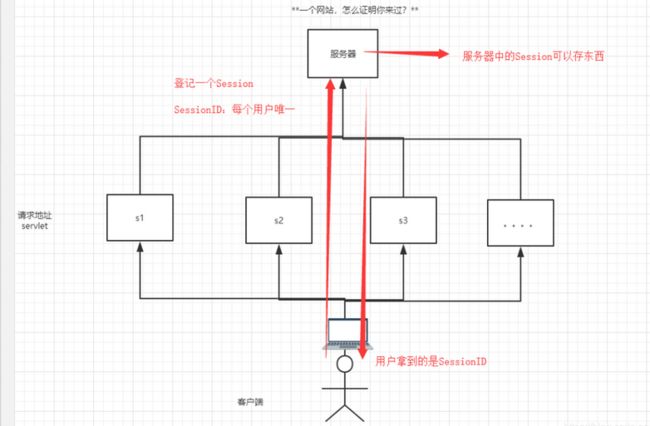
什么是Session:浏览器访问服务器,服务器就会创建一个 session
web 服务程序只要打开,session 就会存在, n n n 个用户(浏览器)访问服务器,服务器会创建 n n n 个 session,通过 sessionId 进行区分,保证每个用户的数据是单独的
- 服务器会给每一个用户(浏览器)创建一个Seesion对象;
- 一个Session 独占一个浏览器,只要浏览器没有关闭,这个 Session 就存在;
- 用户登录之后,整个网站它都可以访问!–> 保存用户的信息;保存购物车的信息……
- Cookie 是把用户的数据写给用户的浏览器,浏览器保存 (可以保存多个)
- Session 把用户的数据写到 用户(浏览器) 独占的 Session 中,服务器端保存 (保存重要的信息,减少服务器资源的浪费)
- Session 对象由服务器创建;
使用场景:
- 保存一个登录用户的信息;
- 购物车信息;
- 在整个网站中经常会使用的数据,我们将它保存在Session中;
使用Session:
新建包 com.kuang.pojo,新建 Person 类
package com.kuang.pojo;
public class Person {
private String name;
private int age;
public Person(String name, int age) {
this.name = name;
this.age = age;
}
public String getName() {
return name;
}
public void setName(String name) {
this.name = name;
}
public int getAge() {
return age;
}
public void setAge(int age) {
this.age = age;
}
@Override
public String toString() {
return "Person{" +
"name='" + name + '\'' +
", age=" + age +
'}';
}
}
public class SessionDemo01 extends HttpServlet {
@Override
protected void doGet(HttpServletRequest req, HttpServletResponse resp) throws ServletException, IOException {
//解决乱码问题
req.setCharacterEncoding("UTF-8");
resp.setCharacterEncoding("UTF-8");
resp.setContentType("text/html;charset=utf-8");
//得到Session,重点:如果当前没有session,则会立刻建立一个session;如果有session则返回当前session
HttpSession session = req.getSession();
//给Session中存东西
session.setAttribute("name",new Person("秦疆",1));
//获取Session的ID
String sessionId = session.getId();
//判断Session是不是新创建的
if (session.isNew()){
resp.getWriter().write("session创建成功,ID:" + sessionId);
} else {
resp.getWriter().write("session已经在服务器中存在了,ID:" + sessionId);
}
//Session创建的时候做了什么事情;
// Cookie cookie = new Cookie("JSESSIONID",sessionId);
// resp.addCookie(cookie);
}
@Override
protected void doPost(HttpServletRequest req, HttpServletResponse resp) throws ServletException, IOException {
doGet(req, resp);
}
}
可以使用其他 servlet 类注销 session
HttpSession session = req.getSession();
session.removeAttribute("name");//删掉键值对
//手动注销该Session
session.invalidate();
session 自动过期也可以通过 web.xml 配置
<session-config>
<session-timeout>15session-timeout>
session-config>
8. JSP
8.1 什么是JSP
Java Server Pages : Java 服务器端页面,也和 Servlet 一样,用于动态 Web 技术!
最大的特点:
- 写 JSP 就像在写HTML
- 区别:
- HTML 只给用户提供静态的数据
- JSP 页面中可以嵌入 JAVA 代码,为用户提供动态数据;
8.2 JSP原理
思路:JSP 到底怎么执行的!
我电脑的地址:
C:\Users\15642\AppData\Local\JetBrains\IntelliJIdea2021.3\tomcat\ff16c1f2-9786-4b44-b19f-140c2743e443\work\Catalina\localhost\ROOT\org\apache\jsp
发现页面转变成了Java程序!

浏览器向服务器发送请求,不管访问什么资源,其实都是在访问 Servlet!
JSP 最终也会被转换成为一个 Java 类!
JSP 本质上就是一个Servlet
JSP源码剖析
//初始化
public void _jspInit() {}
//销毁
public void _jspDestroy() {}
//JSPService
public void _jspService(.HttpServletRequest request,HttpServletResponse response)
final javax.servlet.jsp.PageContext pageContext; //页面上下文
javax.servlet.http.HttpSession session = null; //session
final javax.servlet.ServletContext application; //applicationContext
final javax.servlet.ServletConfig config; //config
javax.servlet.jsp.JspWriter out = null; //out
final java.lang.Object page = this; //page:当前
HttpServletRequest request //请求
HttpServletResponse response //响应
- 输出页面前增加的代码
response.setContentType("text/html"); //设置响应的页面类型
pageContext = _jspxFactory.getPageContext(this, request, response,
null, true, 8192, true);
_jspx_page_context = pageContext;
application = pageContext.getServletContext();
config = pageContext.getServletConfig();
session = pageContext.getSession();
out = pageContext.getOut();
_jspx_out = out;
//输出页面
out.write("\n");
out.write("\n");
out.write("Hello World!
\n");
out.write("\n");
out.write("\n");
在JSP页面中:
-
只要是 JAVA 代码就会原封不动的输出;
-
如果是HTML代码,就会被转换为:
out.write("\r\n");
这样的格式,输出到前端!
8.3 JSP基础语法
准备工作:
- 新建普通 Maven 项目—“javaweb-jsp”,在 pom.xml 中导入依赖
<dependencies>
<dependency>
<groupId>javax.servletgroupId>
<artifactId>javax.servlet-apiartifactId>
<version>4.0.1version>
dependency>
<dependency>
<groupId>javax.servlet.jspgroupId>
<artifactId>jsp-apiartifactId>
<version>2.2version>
dependency>
<dependency>
<groupId>javax.servlet.jsp.jstlgroupId>
<artifactId>jstl-apiartifactId>
<version>1.2version>
dependency>
<dependency>
<groupId>taglibsgroupId>
<artifactId>standardartifactId>
<version>1.1.2version>
dependency>
dependencies>
选择这个,可以实现热部署,就是你修改了源码之后不用再关闭重启服务器了,按照下面的操作就行了,速度会快很多(更改 web.xml 需要重启服务器)
任何语言都有自己的语法, JSP 作为 Java 技术的一种应用,它拥有一些自己扩充的语法(了解,知道即可!),Java所有语法都支持!
JSP表达式
<%-- JSP的注释 --%>
<%--
JSP表达式
作用:用来将程序的输出,输出到客户端
<%= 变量或者表达式%>
--%>
<%= new java.util.Date()%>
JSP脚本片段
<%--JSP脚本片段--%>
<%
int sum = 0;
for (int i = 1; i <= 100 ; i++) {
sum += i;
}
out.println("Sum="
+ sum +"");
%>
脚本片段的再实现
<%
int x = 10;
out.println(x);
%>
<p>这是一个JSP文档</p>
<%
int y = 2;
out.println(y);
%>
<hr>
<%--在代码嵌入HTML元素--%>
<%
for (int i = 0; i < 5; i++) {
%>
<h1>Hello,World <%=i%> </h1>
<%
}
%>
JSP声明
<%!
static {
System.out.println("Loading Servlet!");
}
private int globalVar = 0;
public void kuang(){
System.out.println("进入了方法Kuang!");
}
%>
JSP 声明:会被编译到 JSP 生成 Java 的类中!其他的,就会被生成到 _jspService 方法中!
在 JSP,嵌入 Java 代码即可!
<% 写Java代码 %>
<%= 变量或者表达式%>
<%! 声明%>
<%--注释--%>
JSP的注释,不会在客户端显示,HTML 的就会!
8.4 JSP指令
<%@page args.... %>
<%@include file=""%>
<%--@include会将两个页面合二为一
将代码都写在service中,如果两个页面中定义了相同的变量,会报错--%>
<%@include file="common/header.jsp"%>
<h1>网页主体</h1>
<%@include file="common/footer.jsp"%>
<hr>
<%--jSP标签
jsp:include:拼接页面,本质还是三个
--%>
<jsp:include page="/common/header.jsp"/>
<h1>网页主体</h1>
<jsp:include page="/common/footer.jsp"/>
8.5 九大内置对象
- PageContext 存东西
- Request 存东西
- Response
- Session 存东西
- Application 【SerlvetContext】 存东西
- config 【SerlvetConfig】
- out
- page ,不用了解
- exception
pageContext.setAttribute("name1","秦疆1号"); //保存的数据只在一个页面中有效
request.setAttribute("name2","秦疆2号"); //保存的数据只在一次请求中有效,请求转发会携带这个数据
session.setAttribute("name3","秦疆3号"); //保存的数据只在一次会话中有效,从打开浏览器到关闭浏览器
application.setAttribute("name4","秦疆4号"); //保存的数据只在服务器中有效,从打开服务器到关闭服务器
JSPDemo01.jsp
<%@ page contentType="text/html;charset=UTF-8" language="java" %>
<%
/**
pageContext.setAttribute("test","test",PageContext.APPLICATION_SCOPE);
pageContext.setAttribute("test","test",PageContext.REQUEST_SCOPE);
pageContext.setAttribute("test","test",PageContext.SESSION_SCOPE);
pageContext.setAttribute("test","test",PageContext.PAGE_SCOPE);
PageContext.PAGE_SCOPE控制作用域
*/
pageContext.setAttribute("name1","pageContext_name01");
request.setAttribute("name2","request_name02");
session.setAttribute("name3","session_name03");
application.setAttribute("name4","application_name04");
%>
<html>
<head>
<title>jspDemo01</title>
</head>
<body>
<h1>${name1}</h1>
<h1>${name2}</h1>
<h1>${name3}</h1>
<h1>${name4}</h1>
<%--
EL表达式 ${变量名},如果是null,则不显示,
它的寻找顺序是:pageScope-->requestScope-->sessionScope-->applicationScope
都没找到,就返回null,就不在浏览器显示了
--%>
<h1>${name5}</h1>
</body>
</html>
JSPDemo02.jsp
<%@ page contentType="text/html;charset=UTF-8" language="java" %>
<html>
<head>
<title>Title</title>
</head>
<body>
<h1>${name1}</h1>
<h1>${name2}</h1>
<h1>${name3}</h1>
<h1>${name4}</h1>
<h1>${name5}</h1>
</body>
</html>
JSPDemo03.jsp
<%@ page contentType="text/html;charset=UTF-8" language="java" %>
<html>
<head>
<title>Title</title>
</head>
<body>
<%
pageContext.forward("/jsp/JSPDemo01.jsp");//页面前端转发
/*
* 后台转发
* request.getRequestDispatcher("/JSPDemo01.jsp").forward(request,response);
* */
%>
</body>
</html>
request:客户端向服务器发送请求,产生的数据,用户看完就没用了,比如:新闻,用户看完没用的!
session:客户端向服务器发送请求,产生的数据,用户用完一会还有用,比如:购物车;
application:客户端向服务器发送请求,产生的数据,一个用户用完了,其他用户还可能使用,比如:聊天数据;
8.6 JSP标签、JSTL标签、EL表达式
EL表达式: ${ }
- 获取数据
- 执行运算
- 获取 web 开发的常用对象
JSP标签
<%--jsp:include--%>
<%--
http://localhost:8080/jsptag.jsp?name=kuangshen&age=12
--%>
<jsp:forward page="/jsptag2.jsp">
<jsp:param name="name" value="kuangshen"></jsp:param>
<jsp:param name="age" value="12"></jsp:param>
</jsp:forward>
JSTL表达式
JSTL 标签库的使用就是为了弥补 HTML 标签的不足;它自定义许多标签,可以供我们使用,标签的功能和 Java 代码一样!
格式化标签
SQL标签
XML 标签
- 引入对应的 taglib
- 使用其中的方法
- 在 Tomcat 的 lib 下也需要引入 jstl 的包,否则会报错:JSTL 解析错误
复制 jstl jar 包的绝对路径,找到 jar 包,复制到 E:\tomcatt\apache-tomcat-9.0.60\lib 下
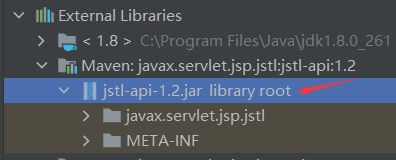
在 web 目录下新建 core.jsp
c:if
<%@ page contentType="text/html;charset=UTF-8" language="java" %>
<%--引入JSTL核心标签库 --%>
<%@ taglib prefix="c" uri="http://java.sun.com/jsp/jstl/core"%>
<html>
<head>
<title>Title</title>
</head>
<body>
<h4>if测试</h4>
<hr>
<form action="core.jsp" method="get">
<%--
EL表达式获取表单中的数据
${param.参数名}
--%>
<input type="text" name="username" value="${param.username}">
<input type="submit" value="登录">
</form>
<%--判断如果提交的用户名是管理员,则登录成功, var是接收test的返回值:false或者true--%>
<c:if test="${param.username=='admin'}" var="isAdmin">
<c:out value="管理员欢迎您!"/>
</c:if>
<%--自闭合标签--%>
<c:out value="${isAdmin}"/>
</body>
</html>
访问 http://localhost:8080/core.jsp 进行测试
c:choose
c:when
<body>
<h4>choose,when测试</h4>
<hr>
<%--定义一个变量score,值为55--%>
<c:set var="score" value="55"/>
<c:choose>
<c:when test="${score>=90}">
你的成绩为优秀
</c:when>
<c:when test="${score>=80}">
你的成绩为一般
</c:when>
<c:when test="${score>=70}">
你的成绩为良好
</c:when>
<c:when test="${score<=60}">
你的成绩为不及格
</c:when>
</c:choose>
</body>
c:forEach
<%@ page import="java.util.ArrayList" %>
<%@ page contentType="text/html;charset=UTF-8" language="java" %>
<%--引入JSTL核心标签库 --%>
<%@ taglib prefix="c" uri="http://java.sun.com/jsp/jstl/core"%>
<html>
<head>
<title>Title</title>
</head>
<body>
<h4>forEach测试</h4>
<hr>
<%
ArrayList<String> people = new ArrayList<>();
people.add(0,"张三");
people.add(1,"李四");
people.add(2,"王五");
people.add(3,"赵六");
people.add(4,"田六");
request.setAttribute("list",people);
%>
<%--
var , 每一次遍历出来的变量
items, 要遍历的对象
begin, 哪里开始
end, 到哪里
step, 步长
--%>
<c:forEach var="people" items="${list}">
<c:out value="${people}"/> <br>
</c:forEach>
<hr>
<c:forEach var="people" items="${list}" begin="1" end="3" step="1" >
<c:out value="${people}"/> <br>
</c:forEach>
</body>
</html>
9. JavaBean
实体类
JavaBean有特定的写法:
- 必须要有一个无参构造
- 属性必须私有化
- 必须有对应的 get/set 方法;
一般用来和数据库的字段做映射 ORM;
ORM :对象关系映射
- 表—>类
- 字段–>属性
- 行记录---->对象
people表
| id | name | age | address |
|---|---|---|---|
| 1 | 秦疆1号 | 3 | 西安 |
| 2 | 秦疆2号 | 18 | 西安 |
| 3 | 秦疆3号 | 100 | 西安 |
class People{
private int id;
private String name;
private int id;
private String address;
}
class A{
new People(1, "秦疆1号", 3, "西安");
new People(2, "秦疆2号", 3, "西安");
new People(3, "秦疆3号", 3, "西安");
}
- 过滤器
- 文件上传
- 邮件发送
- JDBC 复习 : 如何使用JDBC , JDBC crud, jdbc 事务
10. MVC三层架构
什么是 MVC:
Model :模型
view :视图
Controller : 控制器
10.1 早些年
servlet--CRUD-->数据库
弊端:程序十分臃肿,不利于维护
servlet的代码中:处理请求、响应、视图跳转、处理JDBC、处理业务代码、处理逻辑代码
架构:没有什么是加一层解决不了的!
程序猿调用
|
JDBC
|
Mysql Oracle SqlServer ....
10.2 MVC三层架构
- 业务处理 :业务逻辑(Service)
- 数据持久层:CRUD (Dao)
View
- 展示数据
- 提供链接发起 Servlet 请求 (a,form,img…)
Controller (Servlet)
-
接收用户的请求 :(req:请求参数、Session信息….)
-
交给业务层处理对应的代码
-
控制视图的跳转
登录--->接收用户的登录请求--->处理用户的请求(获取用户登录的参数,username,password)
---->交给业务层处理登录业务(判断用户名密码是否正确:事务)
--->Dao层查询用户名和密码是否正确-->数据库
11. Filter (重点)
Filter:过滤器 ,用来过滤网站的数据;
新建普通 Maven 项目—“javawebfilter”,添加 web 支持!

pom.xml 中导入依赖
<dependencies>
<dependency>
<groupId>javax.servletgroupId>
<artifactId>servlet-apiartifactId>
<version>2.5version>
dependency>
<dependency>
<groupId>javax.servlet.jspgroupId>
<artifactId>javax.servlet.jsp-apiartifactId>
<version>2.3.3version>
dependency>
<dependency>
<groupId>javax.servlet.jsp.jstlgroupId>
<artifactId>jstl-apiartifactId>
<version>1.2version>
dependency>
<dependency>
<groupId>taglibsgroupId>
<artifactId>standardartifactId>
<version>1.1.2version>
dependency>
<dependency>
<groupId>mysqlgroupId>
<artifactId>mysql-connector-javaartifactId>
<version>8.0.27version>
dependency>
dependencies>
Filter开发步骤:
先来一个 ShowServlet,展示乱码效果
package com.kuang.servlet;
import javax.servlet.ServletException;
import javax.servlet.http.HttpServlet;
import javax.servlet.http.HttpServletRequest;
import javax.servlet.http.HttpServletResponse;
import java.io.IOException;
public class ShowServlet extends HttpServlet {
@Override
protected void doGet(HttpServletRequest req, HttpServletResponse resp) throws ServletException, IOException {
resp.getWriter().write("请务必乱码");
}
@Override
protected void doPost(HttpServletRequest req, HttpServletResponse resp) throws ServletException, IOException {
doGet(req, resp);
}
}
注册 web.xml
<servlet>
<servlet-name>showservlet-name>
<servlet-class>com.kuang.filter.ShowServletservlet-class>
servlet>
<servlet-mapping>
<servlet-name>showservlet-name>
<url-pattern>/servlet/showurl-pattern>
servlet-mapping>
配置 Tomcat,访问测试结果,成功乱码!
现在,我们使用过滤器解决乱码问题!
package com.kuang.filter;
import javax.servlet.*;
import java.io.IOException;
public class CharacterEncodingFilter implements Filter {
//初始化:web服务器启动,就以及初始化了,随时等待过滤对象出现!
public void init(FilterConfig filterConfig) throws ServletException {
System.out.println("CharacterEncodingFilter初始化");
}
//Chain : 链
/**
1. 过滤中的所有代码,在过滤特定请求的时候都会执行
2. 必须要让过滤器继续通行
chain.doFilter(request,response);
*/
public void doFilter(ServletRequest request, ServletResponse response, FilterChain chain) throws IOException, ServletException {
request.setCharacterEncoding("utf-8");
response.setCharacterEncoding("utf-8");
response.setContentType("text/html;charset=UTF-8");
System.out.println("CharacterEncodingFilter执行前....");
chain.doFilter(request,response); //让我们的请求继续走,如果不写,程序到这里就被拦截停止!
System.out.println("CharacterEncodingFilter执行后....");
}
//销毁:web服务器关闭的时候,过滤会销毁
public void destroy() {
System.out.println("CharacterEncodingFilter销毁");
}
}
在 web.xml 中配置 Filter
<filter>
<filter-name>CharacterEncodingFilterfilter-name>
<filter-class>com.kuang.filter.CharacterEncodingFilterfilter-class>
filter>
<filter-mapping>
<filter-name>CharacterEncodingFilterfilter-name>
<url-pattern>/servlet/*url-pattern>
filter-mapping>
访问测试,成功解决乱码问题!
12. 监听器
实现一个监听器的接口;(有N种)
- 编写一个监听器
实现监听器的接口…
package com.kuang.listener;
import javax.servlet.ServletContext;
import javax.servlet.http.HttpSessionEvent;
import javax.servlet.http.HttpSessionListener;
//统计网站在线人数 : 统计session
public class OnlineCountListener implements HttpSessionListener {
//创建session监听: 看你的一举一动
//一旦创建Session就会触发一次这个事件!
public void sessionCreated(HttpSessionEvent se) {
ServletContext ctx = se.getSession().getServletContext();
System.out.println(se.getSession().getId());
Integer onlineCount = (Integer) ctx.getAttribute("OnlineCount");
if (onlineCount == null) {
onlineCount = new Integer(1);
} else {
int count = onlineCount.intValue();
onlineCount = new Integer(count + 1);
}
ctx.setAttribute("OnlineCount", onlineCount);
}
//销毁session监听
//一旦销毁Session就会触发一次这个事件!
public void sessionDestroyed(HttpSessionEvent se) {
ServletContext ctx = se.getSession().getServletContext();
Integer onlineCount = (Integer) ctx.getAttribute("OnlineCount");
if (onlineCount == null){
onlineCount = new Integer(0);
} else {
int count = onlineCount.intValue();
onlineCount = new Integer(count - 1);
}
ctx.setAttribute("OnlineCount", onlineCount);
}
/*
Session销毁:
1. 手动销毁 getSession().invalidate();
2. 自动销毁
*/
}
- web.xml中注册监听器
<listener>
<listener-class>com.kuang.listener.OnlineCountListenerlistener-class>
listener>
- 编辑 index.jsp
<%@ page contentType="text/html;charset=UTF-8" language="java" %>
<html>
<head>
<title>$Title$</title>
</head>
<body>
<h1>当前有<span><%= application.getAttribute("OnlineCount")%></span>人在线</h1>
</body>
</html>
13. 过滤器、监听器常见应用
监听器:GUI编程中经常使用;
package com.kuang.listener;
import java.awt.*;
import java.awt.event.WindowAdapter;
import java.awt.event.WindowEvent;
public class TestPanel {
public static void main(String[] args) {
Frame frame = new Frame("中秋节快乐"); //新建一个窗体
Panel panel = new Panel(null); //面板
frame.setLayout(null); //设置窗体的布局
frame.setBounds(300,300,500,500);
frame.setBackground(new Color(0,0,255)); //设置背景颜色
panel.setBounds(50,50,300,300);
panel.setBackground(new Color(0,255,0)); //设置背景颜色
frame.add(panel);
frame.setVisible(true);
//监听事件,监听关闭事件
frame.addWindowListener(new WindowAdapter() {
@Override
public void windowClosing(WindowEvent e) {
System.exit(0);
}
});
}
}
下面做个小案例,用过滤器实现权限拦截!
用户登录之后才能进入主页!用户未登录或者注销后不能直接进入主页!
-
用户登录之后,向 Sesison 中放入用户的数据
-
进入主页的时候要判断用户是否已经登录;要求:在过滤器中实现!
web 目录下新建 sys 目录,在其中新建 success.jsp
web 目录下新建 Login.jsp 和 error.jsp
java 目录下新建包 com.kuang.util,包下新建 Constant 类
代码实现
Login.jsp
<%@ page contentType="text/html;charset=UTF-8" language="java" %>
<html>
<head>
<title>登录title>
head>
<body>
<form action="/servlet/login" method="post">
姓名:<input type="text" name="username"><br />
<input type="submit" name="提交">
form>
body>
html>
success.jsp
<%@ page import="com.kuang.util.Constant" %>
<%@ page contentType="text/html;charset=UTF-8" language="java" %>
<html>
<head>
<title>主页</title>
</head>
<body>
<%
//不建议在jsp页面写过滤代码
/**
Object userSession = request.getSession().getAttribute(Constant.USER_SESSION);
if(userSession == null){
response.sendRedirect("/Login.jsp");
}
*/
%>
<h1>登陆成功!欢迎来到主页</h1>
<a href="/servlet/logout">注销</a>
</body>
</html>
error.jsp
<%@ page contentType="text/html;charset=UTF-8" language="java" %>
<html>
<head>
<title>Titletitle>
head>
<body>
用户名或请求错误
<a href="Login.jsp">返回登录界面a>
body>
html>
LoginServlet
package com.kuang.servlet;
import com.kuang.util.Constant;
import javax.servlet.ServletException;
import javax.servlet.http.HttpServlet;
import javax.servlet.http.HttpServletRequest;
import javax.servlet.http.HttpServletResponse;
import javax.servlet.http.HttpSession;
import java.io.IOException;
public class LoginServlet extends HttpServlet {
@Override
protected void doGet(HttpServletRequest req, HttpServletResponse resp) throws ServletException, IOException {
HttpSession session = req.getSession();
//获取前端请求的参数
String username = req.getParameter("username");
if ("admin".equals(username)) {//登录成功
req.getSession().setAttribute(Constant.USER_SESSION,req.getSession().getId());
resp.sendRedirect("/sys/success.jsp");
} else {//登录失败
resp.sendRedirect("/error.jsp");
}
}
@Override
protected void doPost(HttpServletRequest req, HttpServletResponse resp) throws ServletException, IOException {
doGet(req, resp);
}
}
LogoutServlet
package com.kuang.servlet;
import com.kuang.util.Constant;
import javax.servlet.ServletException;
import javax.servlet.http.HttpServlet;
import javax.servlet.http.HttpServletRequest;
import javax.servlet.http.HttpServletResponse;
import java.io.IOException;
public class LogoutServlet extends HttpServlet {
@Override
protected void doGet(HttpServletRequest req, HttpServletResponse resp) throws ServletException, IOException {
Object user_session = req.getSession().getAttribute(Constant.USER_SESSION);
if (user_session != null) {//不为空说明登录着呢
//建议使用移除属性的方法,不建议销毁session
req.getSession().removeAttribute(Constant.USER_SESSION);
resp.sendRedirect("/Login.jsp");
} else {
resp.sendRedirect("/Login.jsp");
}
}
@Override
protected void doPost(HttpServletRequest req, HttpServletResponse resp) throws ServletException, IOException {
doGet(req, resp);
}
}
SysFilter.java
package com.kuang.filter;
import com.kuang.util.Constant;
import javax.servlet.*;
import javax.servlet.http.HttpServletRequest;
import javax.servlet.http.HttpServletResponse;
import java.io.IOException;
public class SysFilter implements Filter {
@Override
public void init(FilterConfig filterConfig) throws ServletException {
}
@Override
public void doFilter(ServletRequest req, ServletResponse resp, FilterChain chain) throws IOException, ServletException {
HttpServletRequest request = (HttpServletRequest) req;
HttpServletResponse response = (HttpServletResponse) resp;
if (request.getSession().getAttribute(Constant.USER_SESSION) == null){
response.sendRedirect("/error.jsp");
}
chain.doFilter(request,response);
}
@Override
public void destroy() {
}
}
Constant 类
package com.kuang.util;
public class Constant {
public static final String USER_SESSION = "USER_SESSION";
}
web.xml
<servlet>
<servlet-name>LoginServletservlet-name>
<servlet-class>com.kuang.servlet.LoginServletservlet-class>
servlet>
<servlet-mapping>
<servlet-name>LoginServletservlet-name>
<url-pattern>/servlet/loginurl-pattern>
servlet-mapping>
<servlet>
<servlet-name>LogoutServletservlet-name>
<servlet-class>com.kuang.servlet.LogoutServletservlet-class>
servlet>
<servlet-mapping>
<servlet-name>LogoutServletservlet-name>
<url-pattern>/servlet/logouturl-pattern>
servlet-mapping>
<filter>
<filter-name>SysFilterfilter-name>
<filter-class>com.kuang.filter.SysFilterfilter-class>
filter>
<filter-mapping>
<filter-name>SysFilterfilter-name>
<url-pattern>/sys/*url-pattern>
filter-mapping>
启动服务,测试结果
为啥我的过滤器没起作用?注销之后还能直接访问 success.jsp,复习的时候再解决吧…

